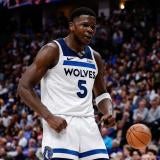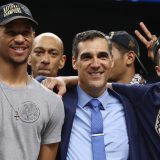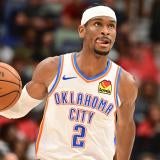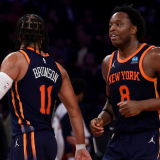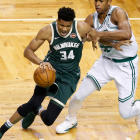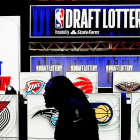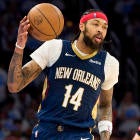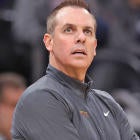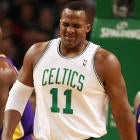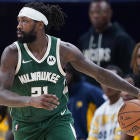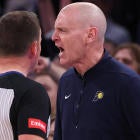The defining quality of the 2017-18 Milwaukee Bucks was their capacity to leave you wanting more. It is fitting, then, that after coming back from a 2-0 deficit in their first-round series and staving off elimination on Thursday, they suffered a lopsided loss in Game 7 on Saturday.
The final score was 112-96, but it felt like a blowout. A late scoring explosion from Khris Middleton (32 points on 11-for-18 shooting), a much-needed efficient night from Eric Bledsoe (23 points on 9-for-12 shooting) and the presence of The Best Player In The Series (Giannis Antetokounmpo) were not enough to win in a pressure-packed situation on the road. More disturbing: All of this was not even enough to get the Bucks in striking distance.
Ordinarily, losing in seven games to the No. 2 seed would not feel nearly this disappointing. This, however, was no ordinary situation. The Celtics were without stars Kyrie Irving and Gordon Hayward and reserve Daniel Theis all series and without glue guy Marcus Smart for the first four games. In the clincher, they won largely without the services of rising star Jaylen Brown, who left the game because of a hamstring injury after playing 16 minutes.
Like it had all season, Boston compensated for its banged-up roster with disciplined defense and an offensive system that maximizes the strengths and minimizes the weaknesses of its personnel. Under coach Brad Stevens, the Celtics have wildly overachieved. Under coaches Jason Kidd -- fired in January -- and Joe Prunty, the Bucks never quite figured out how to play together.
As Milwaukee reflects on the fact it came up short, here are four questions about what went wrong and how it can get back on the right track:
Can the Bucks take anything positive from this season?
Sure. Antetokounmpo is a once-or-twice in a generation player, and the fact that he has continued to improve so drastically every year should not be taken for granted. Antetokounmpo increased his usage rate while lowering his turnover rate, became a better all-around defender and improved his scoring and rebounding on a per-minute basis. And now he has experienced a Game 7 atmosphere.
Beyond that, Middleton had a career year. He is one of the most dangerous midrange shooters in the game, and this was the first season he averaged more than 20 points (with a career-high 57.7 percent true shooting percentage). Imagine how efficient he could be if he became a high-volume 3-point shooter.
Also, just like last year, the enigmatic Thon Maker had some nice moments in the postseason. The Bucks wouldn't have won Games 3 and 4 at home without him.
How much did coaching contribute to this underwhelming season?
A whole lot. Under Kidd, Milwaukee played way too aggressively on defense, needlessly surrendering corner 3s and layups. Prunty dialed that back a little bit -- and had the Bucks playing much more conservatively in the playoffs -- but those problems persisted. On the other end of the floor, there was a maddening lack of ball and player movement, which contributed to the team having a shot profile that definitely does not scream "modern NBA."
With Milwaukee's season on the line and the team trailing in the third quarter, Prunty called on a hopeless defensive lineup that featured Jason Terry, Shabazz Muhammad and Jabari Parker playing together. There were puzzling rotation decisions like this all series long, but I wouldn't even say this was the biggest issue. Last May, I suggested Milwaukee needed to play with more discipline and establish an identity like that of the Miami Heat: aggressive, fast and physical. The Bucks did know that they needed to force turnovers and get out in transition, but they lacked both the focus required for this to work properly and the foundation of purposeful halfcourt basketball to fall back on. Whoever is coaching them next year needs to give them some structure.
What about the roster?
Prunty is taking some heat for losing to this unremarkable Celtics roster, but it's not as if he had a ton of proven rotation players to throw out there. All across the league, the first round has illustrated the importance of depth. The league's best teams have options when it comes to playmakers, versatile defenders and the shooters required to space the floor. Milwaukee is deficient in all of these areas.
Bledsoe, acquired a few weeks into the season, was supposed to help the Bucks ascend to the East's upper echelon. He put up pretty good numbers, especially in the regular season's final couple of months, but consistently made perplexing decisions on both ends of the court. Bledsoe's bad habits -- taking low-percentage shots, gambling on defense, taking plays off -- became even more frustrating in the playoffs. The 28-year-old's talent is undeniable, but he is heading into a contract year and Milwaukee's front office must think about whether or not he should be a part of the long-term core. Boston's Terry Rozier thoroughly outplayed him.
Parker's situation, which has been discussed elsewhere, is even more pressing. The former No. 2 pick had an erratic series and is entering restricted free agency at an awkward time.
The biggest problem: While the Bucks might feel like an up-and-coming team, they are not constructed like one. Even if they let Parker walk, they will have $103 million of committed salary, meaning their avenues to improve the roster are limited to their mid-first-round pick in June, the $8.6 million midlevel exception, the $3.4 million biannual exception, the trade market and minimum contracts.
Milwaukee is a textbook case of the risk that comes with investing significant salary in role players when your team is not near contention. John Henson is owed about $22 million over the next two years, Matthew Dellavedova is owed about $19 million over the next two years and Tony Snell is owed about $34 million over the next three years. Even with Middleton on an incredible contract for one more season, the Bucks lack flexibility.
This section, by the way, is not meant to completely absolve the coaching staff of responsibility. Henson, Dellavedova and Snell might have actual trade value if they had been playing in a system that helped role players thrive.
Where does Giannis go from here?
Antetokounmpo checks all the boxes needed to be a future MVP. He should make first team All-NBA and All-Defense this season, and he means everything to this franchise. There are obvious areas where he needs to improve -- the jump shot is still very much a work in progress, and he doesn't quite pick defenses apart with precision passing the same way that guys like LeBron James and, say, Ben Simmons do -- but his development might be as much about what Milwaukee does than what he works on in the summer.
Can you imagine what Antetokounmpo would look like if he was surrounded by four deadly 3-point shooters on every offensive possession? What about if he learned how to be more of a threat as a screen-setter and cutter away from the ball as part of a movement-oriented system? It is easy to envision Antetokounmpo eventually being in command of a truly elite offense, but it is up to the front office and coaching staff to put him in this position. With a great player like this comes great responsibility.







